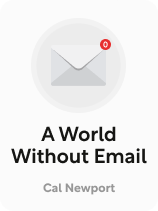

This article is an excerpt from the Shortform book guide to "A World Without Email" by Cal Newport. Shortform has the world's best summaries and analyses of books you should be reading.
Like this article? Sign up for a free trial here.
Are you having communication issues at work? What workplace protocols can fix these problems?
If you’re working with other people, communication is an important part of the job. By setting workplace protocols in place for communication purposes, your employees’ productivity will soar through the roof.
Continue reading for different protocols that you can test out at work.
The Protocol Principle
Beyond setting up workflows that efficiently extract value from knowledge work, Cal Newport in A World Without Email recommends that companies set up rules for how people communicate to reduce inefficient cognitive switching and unnecessary work. This is the protocol principle. Rules can be challenging to implement in the short term but can result in greater communication and productivity in the long term.
(Shortform note: Like “the process principle,” the “protocol principle” is a slightly vague term, as we use the word protocol loosely across many contexts. We might consider “communication conventions” as a substitute for “protocol,” as this perhaps more pointedly conveys the idea that a workplace must institute standards for communication. )
Newport recommends setting up workplace protocols for several aspects of your work.
1. Protocols for Scheduling Meetings
Create protocols that dictate how meetings are scheduled, a process that can otherwise be cognitively draining and time-consuming. Newport recommends hiring a full-time or part-time human assistant if possible or otherwise using a digital scheduling service. This lets employees list their availability and allows others to book time slots with them.
(Shortform note: While a digital scheduling service may indeed be more efficient for the employee, do the people making appointments with such services like them? It seems users appreciate the flexibility of being able to schedule appointments at their convenience, but there’s also evidence that, in general, most people usually prefer a human interaction over an impersonal one. Perhaps you might schedule initial meetings via email to establish trust and then ask the other person to use your service thereafter.)
2. Protocols for Answering Questions
To better answer on-the-fly questions, have employees hold office hours: set times that they’re available during the day or week. Others can thus approach a knowledge worker with questions only when they’re available to answer them. Newport acknowledges this only works for questions that don’t require an immediate response.
(Shortform note: While from a productivity standpoint, reducing interruptions and cognitive switching is superior to a workday punctuated by unscheduled interruptions, from a mental health perspective, unscheduled interruptions can be beneficial. Some argue that interruptions offer the chance to have casual social interactions that create a sense of connection at work.)
3. Protocols for Clients
In setting up workplace protocols for clients, make it easy for them to follow progress on a project without having to send many emails—a portal or project page can facilitate this, writes Newport. Be clear in the contract with clients about how you’ll communicate with them. Finally, when necessary, implement crisis protocols—ways for the client to reach you in an emergency.
(Shortform note: The prospect of setting the terms of your interactions with clients might seem uncomfortable: Most of us operate under the assumption that the business should adapt to the client’s needs. But others feel that not only should you set the terms of your client interactions, but you should also fire clients who are bad for your business because they take up too much time or don’t listen to your advice.)
4. Protocols for Email
Consider strictly limiting email length, advises Newport. This ensures that only the simple communication suited to the email format is handled that way and that any other communication happens in person.
(Shortform note: Writing short emails isn’t easy for many. To write more succinct emails, you may need to spend more time on them to pare down your message to its core meaning. One technique that can help is to make full use of the subject line to explain why you’re writing and what you need from the recipient.)
When it comes to communication with entities outside the company, like clients and vendors, you might ask these entities to email a general inbox rather than individual employees. This decreases the expectation on the part of clients and vendors that your employees will check their accounts frequently and feel a personal obligation to respond. For clients, you might even set up an email account with their name—clientname@yourcompany.com—and ask them to send queries to this address.
(Shortform note: For Newport’s proposed email protocol to work, someone at the company must check the client’s email account and action emails. Customer relationship management systems (CRMs) can help with this communication flow and keep employees accountable. CRMs are softwares designed to capture information from the customer or client, transform it into an action item—a task, for instance—and then track the progress on that action item.)
5. Protocols for Status Meetings
Decide on a brief standing meeting slot one or multiple times a week, asserts Newport. Have everyone provide updates in this meeting. This gets the team on the same page, limits the amount of impromptu written communication that must happen, and frees up time for potential longer meetings that emerge from the status meeting.
(Shortform note: While Newport’s vision for status meetings likely improves efficiency and communication, it may not be optimally engaging. This is what Death by Meeting author Patrick Lencioni feels to be the problem with most meetings: They’re boring and often useless. To counter the monotony and lack of engagement during meetings, Lencioni advises that you find the drama in meetings: a reason for employees to be engaged (what Lencioni refers to as the hook) and sources of disagreement (the conflict).)

———End of Preview———
Like what you just read? Read the rest of the world's best book summary and analysis of Cal Newport's "A World Without Email" at Shortform.
Here's what you'll find in our full A World Without Email summary:
- How email makes knowledge workers less productive and more unhappy
- How to improve the channels through which people communicate
- Why you should implement protocols to reduce unnecessary work






